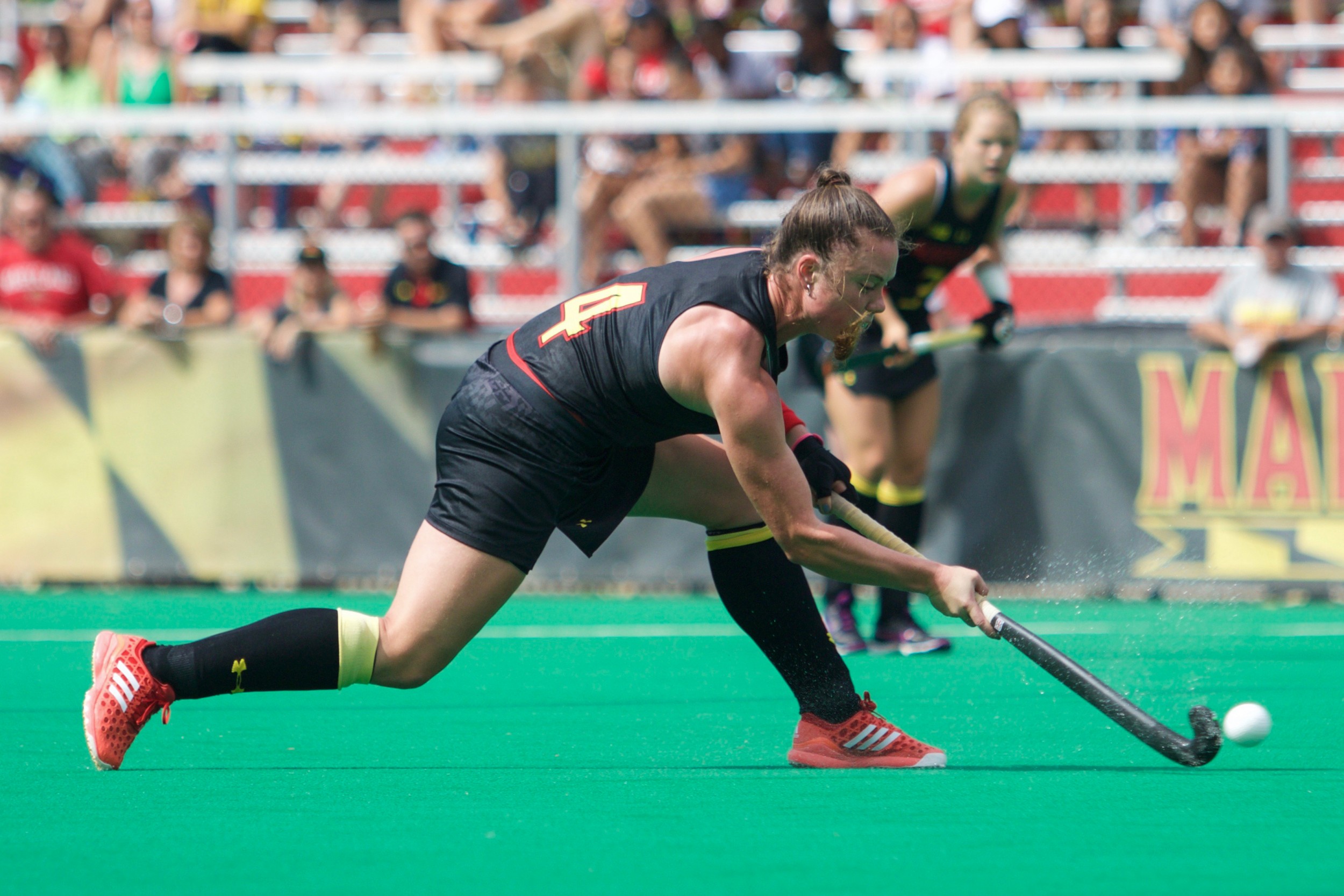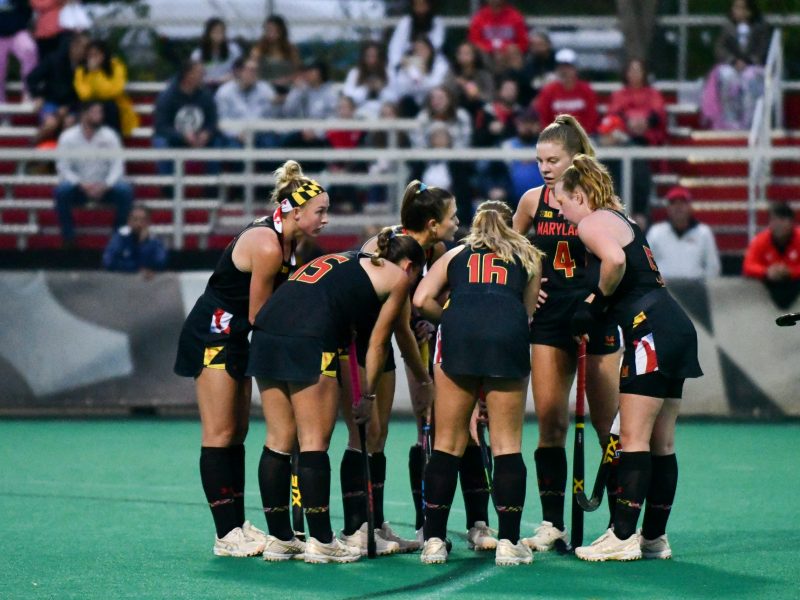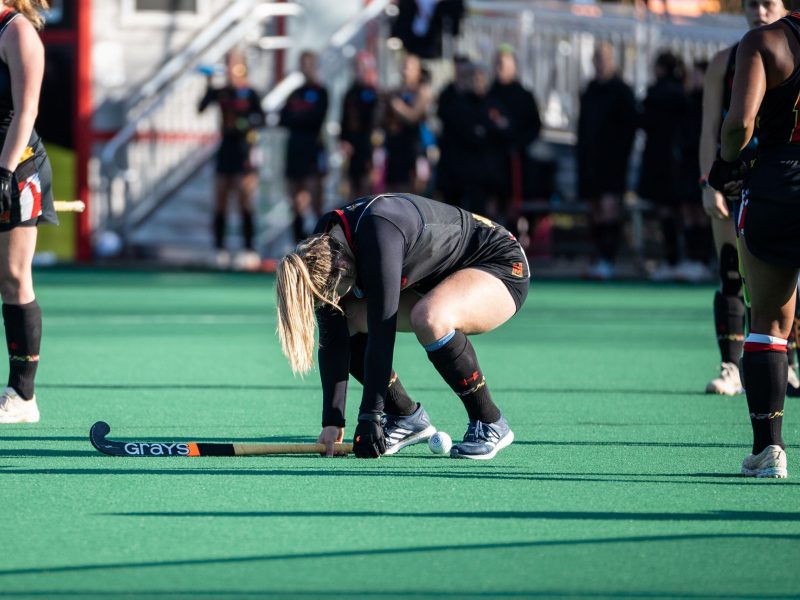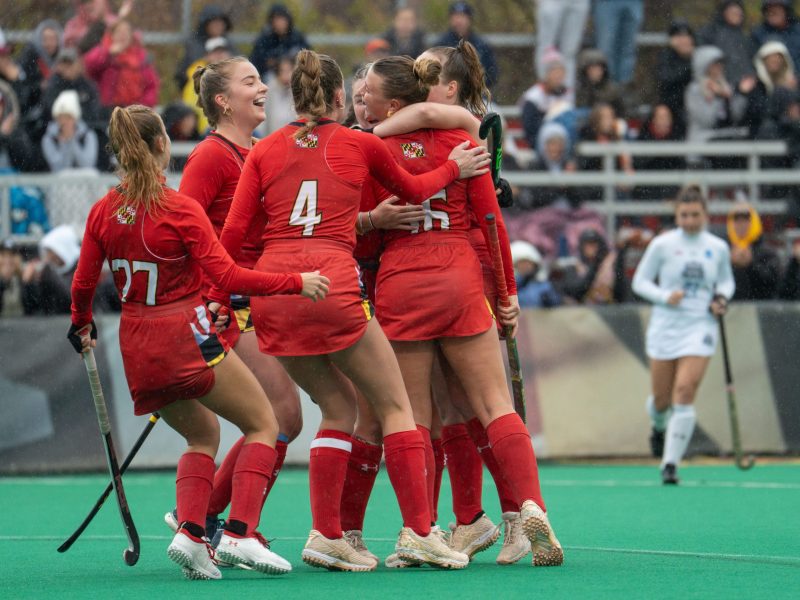Grace Balsdon knew she would be packing her bags and leaving the country in early August. She just didn’t exactly know where she would be headed.
The Canterbury, England, native hoped she would be invited to Rio as part of the Great Britain field hockey Olympic team. If she didn’t make that roster, she would be coming to College Park to join Maryland field hockey as a graduate transfer.
On the last day of the Olympic field hockey tournament, surrounded by teammates she had met just weeks before, Balsdon watched the countrywomen she’d known for years beat Netherlands to win Great Britain’s first gold medal.
She cried, but they were tears of joy for her friends’ accomplishment. She had already moved past the disappointment of not making the cut and was focused on her three-month college career.
“When you don’t get selected for something, whatever it is, it’s always devastating because you desperately want to be a part of something,” Balsdon said. “What you have to do is look at the positives. Someone always says you’re doing these things really well, but there’s these things you can work on.”
**
Maryland’s program had known of Balsdon for more than five years, dating back to her time in high school in England.
She’s been a standout even longer than that.
Neither of her parents were big field hockey players — her mom was more focused on tennis and her dad more into soccer — but a PE teacher provided Balsdon the impetus to consider the sport.
“One of the winters my school offered it, and I kind of took it up,” Balsdon said. “And my PE teachers said, ‘I think you should take a look into a club.'”
Balsdon joined the Canterbury Hockey Club as a member of the U-9 team and rose through the ranks. She made her first appearance on the senior team — the team she still plays on and captains as a 23-year-old — at age 14.
At that time, she hadn’t fully dedicated herself to field hockey, continuing to play other sports on the side. National team attention came not long after.
“It was always a possibility to come to the States for my whole undergraduate,” Balsdon said. “But then I was fortunate to be picked up into the Great Britain international program.”
Maryland coach Missy Meharg stopped recruiting Balsdon when she realized Balsdon would be involved in the national team.
So the center defender stayed in England, playing for the same club she had played for more than a decade, attending her hometown university and spending time on the British U-18 and U-21 teams.
She earned her first senior cap in January 2014 against Scotland and graduated from Canterbury Christ Church University later that year.
But entering 2016, Balsdon hadn’t become a regular for Team GB. She had 12 total caps for the squad and didn’t make the rosters for major tournaments.
**
On the other side of the Atlantic Ocean, Meharg was thinking about several factors as she began the process of preparing for the 2016 season.
First, her team needed a center back. Sarah Sprink, a four-year starter, three-time All-American, Big Ten Defensive Player and Player of the Year during her time at Maryland, finished her career when the Terps lost to Princeton in the first round of the NCAA tournament in November.
Meharg didn’t feel anybody on her projected roster was ready to fill the hole Sprink left behind.
“[A transfer] was something we needed to do while we developed younger players,” Meharg said.
Second, it was an Olympic year.
“You go around the world and you look at all the teams and a lot of women are still of age to play in the NCAA but might not make the Olympic roster,” Meharg said.
So she scoured various international rosters, including Germany, Argentina and Australia, searching for somebody to provide a stopgap at center back.
She found Balsdon.
“She was playing on her club … and we have two past Maryland Terrapins — Susie Rowe and Hayley Turner — that actually play on Canterbury,” Meharg said. “So I got in touch with them … and they said Grace might be interested.”:g.
“They pushed me. They said, ‘Oh you have to do it if you have the time,” Balsdon said. “‘You have to experience it. The school is fantastic, the environment that Missy creates and the coaching. You need to go and be a part of it.'”
Their testimonies convinced her.
“They said, ‘Don’t be afraid, I’ve been there, you won’t be completely alone,'” Balsdon said. “As soon as I knew this would be an opportunity, I jumped headfirst and thought, ‘Yeah, why not?'”
**
Before Balsdon got here, though, she heard the difficult news about the Olympic team.
“It’s like having someone die that you know is going to die,” Meharg said. “Until you’re not selected, you believe you have a chance. So I’m just so happy that Grace chose to take this on.”
Adjusting to training camp with a new team and looking ahead to more than 20 games in three months kept Balsdon’s mind off any potential Olympics pain.
Plus, part of the reason Balsdon came to Maryland was to gain experience that will help her prove herself for future national team roster decisions.
“The opportunity to come and play a really good standard of hockey in a very short period of time and work on those areas,” Balsdon said. “That’s exactly what Maryland created for me.”
One area of improvement was her communication, which was tough early in the year.
“I know from being international and coming in, you don’t want to overstep your bounds and be super vocal and stuff,” midfielder Lein Holsboer said.
Faye Curran, who played with Balsdon as a teenager in England and for the Terps last year as a graduate transfer, said acclimating is a delicate process on and off the field.
“You don’t want to be too loud because people will see you as bossy,” Curran said. “So you wait a little bit, see what kind of playing time you’re going to get and how you react. It’s a managing game; where do I sit and how can I be effective?”
Once she got used to the different language and jargon of her new team, Balsdon said it was natural for her to step up as a strong communicator at the starting center-back position.
As the season’s worn on, she’s come into her own, the team said.
“She just had to settle in and find her role,” forward Welma Luus said. “Once she did and got more comfortable with all of us and our style of play, she’s found her voice back there. She communicates loud and early and helps us structurally, because that’s the position you can see the whole field from.”
Her voice could play a significant role in Balsdon’s national team future, Meharg said. The 29th-year head coach is in contact with the British coaches often, and said that an increased volume could help call attention to her other positive traits, too.
“It was something she needed in order for her to make a presence when she goes back,” Meharg said. “Make that call, ‘Hi, I am back, and this is my level now.'”
Balsdon also needed to work on moving forward to offense more often and more effectively, Meharg said. She’s also done that, tracking players into the offensive half and earning a few assists from hard-hit balls into the circle.
That’s not where most of her offensive production comes from, though.
**
Even though Balsdon’s a defender, perhaps her most lethal skill comes on offense.
When Balsdon was 16, the same age she devoted herself solely to field hockey, Kwan Browne joined the Canterbury coaching staff. Browne, a former Trinidadian player who also served as a volunteer assistant coach at North Carolina in 2005, used the drag flick as a player and coaches it now.
Balsdon went to Browne looking to “become a player who is dominating,” and Browne suggested she learn the move.
In field hockey, a player isn’t allowed to hit the ball above about knee height, but a drag flick doesn’t have a backswing, so it’s not a technical “hit.” The player receives the ball, whips their stick through their body and sends the ball flying.
It took her a while, but Balsdon eventually figured out the skill.
“When you start, you feel so awkward and rubbish, and you think it’s never going to go anywhere,” she said. “Over the years of him teaching me, you gradually begin to develop more power. At first I could only go in the low corners, but as you develop that technique I was able to create the elevation that give you options on the goal.”
On most penalty corners, where drag flicks are often most effective, a goalkeeper’s best defense is to lie down and spread out.
But against a good drag flicker, goalies can’t eliminate the entire net.
“The way she moves her body is so deceptive,” Curran, who was a commentator for the team’s games on BTN2GO this season, said. “Everything on her body says low, and her body weight takes it to the right. But she has the ability to take it to the left, and she’s pretty consistent.”
Balsdon has used the drag flick to score 13 goals this season. Eleven came from penalty corners and the other two from penalty strokes.
Curran said Balsdon’s drag flicks are better than any American’s “by a country mile” and ranks among the best she’s ever seen.
The rest of the team concurs.
“Her drag flick against UConn, there’s not a lot of people that can stop that,” Meharg said of Baldson’s upper-right corner score against the Huskies. “She has the best in the country right now.”
Because defenses have to pay so much attention to her as the team’s primary threat on penalty corners, she can also be used as a decoy on plays. Some of her five assists have come from the top of the circle on corners.
“The nice thing about being a center back is their physiology isn’t so wiped,” Meharg said. “When they do a set piece skill, they don’t have a high heart rate, so she’s able to come up. She separates very well from field play to penalty corners. She’s very good with that.”
**
The drag flick allows Balsdon to maximize her impact on both ends of the field and helped win the Big Ten Defensive Player of the Year award.
Her transfer to Maryland came with to an eye toward the future in addition to short-term benefits — a distraction from a painful roster exclusion that could also help put her on future squads; a center-back that can score in 2016 while Meharg grooms a younger player for 2017 and beyond.
Now, the season nears its end. After winning the Big Ten with a 15-3 record and a finishing as runner-ups at the conference tournament, the Terps are the No. 2 seed in the NCAA tournament and will begin play this weekend.
Balsdon will don the red and black alongside a group of players she didn’t know four months ago and likely will never play with again in a couple of weeks.
But for more than 20 games, she brought steady defense and opportunistic offense, nine months after Meharg found her on what is effectively a free-agent market and decided to give her a call.
“For the one year of eligibility that Grace is able to play, she afforded us [an answer to] a real void,” Meharg said. “She’s a great addition to this team. But more importantly, she’ll be part of the Maryland family forever. She’s a Maryland Terrapin forever.”



